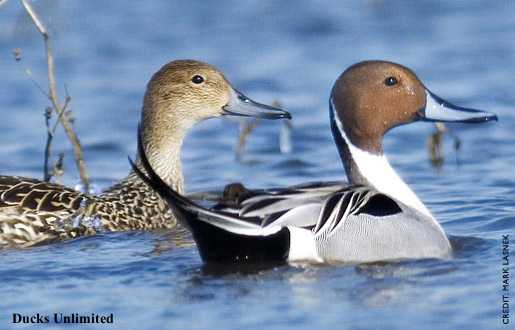 Northern Pintail Northern PintailAnas
acuta (aka Sprig)
Description
Pintails are fairly small
ducks, having a wingspan of about 9 to 11 inches,
a body length of 23 to 30 inches and weighing
between 1 and 3 pounds. Males are slightly larger
than females.
Adult male pintails have a dark
brown head and white breast with a white streak
extending up the side of the head. They have
black and white speckled feathers on their back,
and a yellow patch of feathers just above and
behind their feet. They also have a long, thin
tail feather than can measure up to 4 inches
long. This feather narrows down to a sharp point
and is where they get their common name. Adult
females have more a drab, gray color, and her
"pin tail" feather is only about an
inch long. Both sexes have bluish-gray bills.
Immature pintails are generally
buff colored; their bills are dark, their heads
range in color from dark brown to tan, their
bellies are speckled white and brown, and their
tail feathers are dark, with cream-colored eges.
Distribution and
Habitat
During the summer northern
pintails are found mainly in the Northern
Hemisphere, as far south as Poland and Mongolia
in Eurasia and California in North America. In
the winter, they migrate to the Southern
Hemisphere, including parts of Africa and all of
Mexico; some even make their way to Hawaii --
they are, in fact, the most plentiful of the
migrating ducks in Hawaii. They live in marshes,
ponds, lakes, rivers, canals, and occasionally
grain fields.
Reproduction
Mating season begins in early May and
continues until the end of July. Seven to nine
cream-colored eggs are laid, one per day, and
incubated by the hen alone for 22 to 24 days.
Ducklings can swim and feed almost immediately
after hatching, and fledge at about 47 days. The
family will stay together until the hen re-grows
her flight feathers, upon which time she leaves
the chicks
Pintails become sexually mature at one year.
Diet
Pintails are dabbling ducks, meaning they
submerge their head and upper half of their body
to feed on snails, water bugs and roots of
aquatic plants. On land they will feed on grains,
seeds, leaves, nuts, and insects.
Scientific
Classification
phylum Chordata
subphylum Vertebrata
class Aves
order Anseriformes
family Anatidae
subfamily Anatinae
genus & species Anas acuta

Animal Diversity Web http://animaldiversity.org/accounts/Anas_acuta/
Questions or comments about
this page?
|



